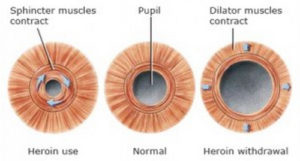

Swelling inside your eye can make it hard for your pupils to get bigger. This can make it harder for you to see at night. The muscles that work your pupils can get weak and have a tough time opening them. Your pupils tend to get smaller as you get older, too. It's normal for a newborn's pupils to stay small for about 2 weeks so their eyes have extra protection from bright light. The most commonly abused drugs that affect pupil size include cocaine, LSD, MDMA, heroin, methamphetamine, and ketamine.Īge. This allows medical professionals to take a better look at your inner eye. Illegal or recreational drugs can also produce noticeable changes in pupil size. Your ophthalmologist or eye doctor might give you eye drops that widen or dilate your pupils.

Both prescription and over-the-counter drugs can cause your pupils to expand or contract. The pupils can also widen if you're concentrating hard on a particular task like solving a math problem or retrieving a memory. In general, pupils tend to grow wider if you vividly feel a positive or negative emotion. Seeing strong emotional cues like a person laughing or crying could also cause differences in pupil size. The pupils slightly expand or dilate every time you feel excited or nervous. Processing or experiencing emotions leads to changing pupil sizes too. Pupils also make small adjustments in size to help you focus better on a close or distant object.Įmotions. The pupils in both eyes respond independently to bright or dim light, so it's possible for one pupil to expand or contract while the other remains stable. Variations in lighting conditions are the most common reason for a change in pupil size. Past physical injuries to the eye or the head can also have a long-lasting impact on the average pupil size. Pupil size can change dramatically in response to not only light but also your emotions, periods of intense concentration, recently eaten foods, prescription and recreational drugs, and underlying diseases or disorders. For example, the pupil is the widest around age 15, after which it begins narrowing in an inconsistent fashion after age 25. The maximum pupil size also varies significantly among age groups. In an adult, the pupil's diameter usually varies between 2 and 4 millimeters in bright light and between 4 and 8 millimeters in dim light.

If the pupil doesn't vary in size in response to changes in lighting and gaze, there might be something wrong. Your pupil's size can also change depending on whether you're looking at nearby or far-away objects. In dark surroundings, the pupil expands to let more light in. If you're in a bright environment, the pupil will shrink in size to allow less light to enter the eye. This is called abnormal miosis, and it can happen in one or both of your eyes. If your pupils stay small even in dim light, it can be a sign that things in your eye aren't working the way they should. When your pupil shrinks (constricts), it's called miosis.


 0 kommentar(er)
0 kommentar(er)
